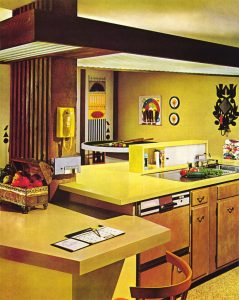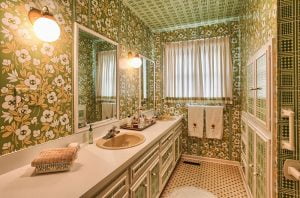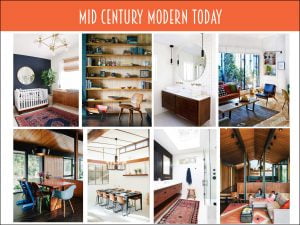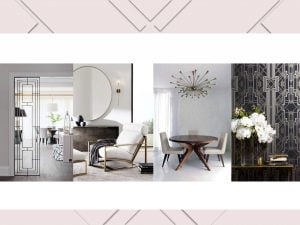Interior Design Influences Throughout History
The fabulous thing about design is the resurgence of influence from previous periods. Let’s take a look back in time and see the key interior design and interior decoration influences from the decades that still inspire us today.
Early 1900s
There was a lot going on in the early part of the century. From the fine decorative pieces of Art Nouveau to Federation influences including a range of architectural styles like the elegant and simple style of Queen Ann and Romanesque revivals. Simple archways and window treatments offered charm, while the Arts and Crafts movement of this era celebrated simple forms and traditional craft techniques using folk style decoration. Art Deco celebrated more elaborate design with geometric textures, rounded mirrors and more glamour being introduced.
The 1920s brought the ‘Roaring Twenties’. With the ending of WWI, it was a time where things such as jazz music, Art Deco and modern technology blossomed, making them more affordable. Such elements gave a ‘modern’ influence to the design style of this era.
1920s kitchen colour trends were soft, muted tones, with white being the most popular colour due to the minimal, utilitarian interiors brought by the idea of a ‘disease free environment’.
Living rooms were somewhat the opposite of the kitchen. They still had the practical, functional components but the colour schemes and furnishings were often very colourful and inviting. Painted walls and ceilings were adorned with yellows, pale greens or ivory hues and soft furnishings introduced colour and pattern.
Floors were often oak hardwood that had been stained to a ‘natural’ colour finish with big rugs throughout for warmth and comfort. Colourful, patterned tiles often adorned entrances and utility rooms.

Image board by ISCD student, Lee-Anne Rosa
1940s to 1950s
With the first half of the 1940s dominated by WWII, redesigning of homes didn’t start until the end of the war in 1945 due to material and product shortages. Once production had set sail again, the designs within homes were very family oriented, with spaces created to cater for social events and entertaining family and friends. Mid ’40s onwards saw the start of the “Baby Boomers”, a generation that were growing up with a more positive outlook. This was reflected in the fun, functional interiors as people were enjoying life again.
The Bauhaus movement was in full swing during this period building on the utilitarian mindset of the war; ‘form follows function’ central to the philosophy. This revolutionary ethos questioned the effectiveness of craft, art and design, affecting all disciplines globally. The result in interiors was open-plan spaces, fabulous new products such as the Douglas Snelling chair as the introduction of mid-century modern influenced interiors.
From a colour point of view, the mid 1940s saw bold, deep primary colours evolve throughout the home. Red being the most popular hue and often combined with green as a secondary colour.
Bright, geometric patterned linoleum floors were popular in kitchens. Adoption of electric refrigerators and cookers came into play and in true Bauhaus influence, kitchens became practical in design.
Living areas were often clutter-free open spaces. Simple, floral patterns were introduced in soft furnishings and as the previous hardwood floors became outdated, wall-to-wall carpeting became a popular option.
1948 saw the arrival of Harry Seidler to Australia, designing a new home for his parents in Sydney. From designing domestic homes, he soon progressed to large scale commercial buildings and transformed the Sydney skyline making deep and impactful design influences that we still feel today.
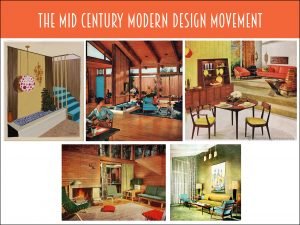

Image boards by ISCD student, Jessica Crocombe
1960s, ’70s and ’80s
This transitional period had many historical influences. The race to get to space ignited futuristic designs, while the first ‘blockbuster film’ Jaws and the release of the famous Space Invaders video game played with designers’ imaginations. With all this going on, we also had lots of patterned wallpapers; usually big, bright flowers or geometric shapes in the colour scheme of orange, yellow, brown, avocado green and white.
Kitchens were of a similar colour palette with brown, yellow and green taking to the walls, cabinets and floors. Having bright yellow linoleum floors was ‘fashionable’ and kitchen islands were introduced as the place for guests to socialise as well as improving function for food preparation.
Living areas were just as colourful as the kitchen, often described as ‘futuristic’ with lava lamps, ball chairs and opal glass coffee tables taking centre stage. Rooms were filled with shag pile rugs, colourful sofas and plenty of house plants.
Some iconic chairs of this era were by Grant Featherston. His designs have been re-launched in recent years cementing him as one of Australia’s most well known designers. Working with plywood, he created designs to mirror the contours of the human form. His most famous chairs include the Scape Chair, the Delma Chair and the Obo Chair, some of which were created in collaboration with his wife Mary Featherston.
Image 1: loggr.me
Image 2: pictot.com
1990s and 2000s
Now we get to the technology decades. From the launch of dial up internet, to cable television and the release of the first Harry Potter book! Things like inflatable chairs and carpeted bathrooms became trends and the younger generation became obsessed with computer gaming systems and talking toys like the Furby.
Minimalism took hold in homes throughout the 1990s, with colours like ivory, beige and white covering the walls throughout the house. That being said, children’s bedrooms of this decade were usually far from minimal, with schemes often influenced by the child’s favourite colours, resulting in a kaleidoscope of contrasting colours used on walls, bedding and curtains.
Kitchen cupboards were usually made of oak or pine wood and worktops in laminate, giving the whole kitchen and dining area a very country-style, ‘cosy’ look. Primary colours were still present throughout some of the rooms to brighten up the usual beige/ivory palette.
Living areas were brought to life with floral sofas and cushions, complete with matching draped curtains and tie backs. Wicker furniture for the conservatory and outdoor areas was a charming feature, while textured wallpapers continued to be a popular choice throughout the house.
Marc Newson’s Embryo chair is an iconic piece from this era. Its minimalistic style and simple geometric lines celebrated organic shapes from nature. A prolific Australian designer, his work is globally recognised as some of the most influential in this contemporary design period.
Present Day
Design today is a great montage of these influences. From Florence Broadhurst designs reprinted onto toasters for the kitchen to artisan Italian hand painting techniques being applied to Smeg fridges by Dolce and Gabbana. The influences of the past are a great way to inspire interesting design ideas today. Here are some historically influenced interiors to inspire you to keep looking at the past when designing new applications.
Image board 1: by ISCD student, Jessica Colvin
Image board 2: by ISCD student, Jessica Crocombe
Image board 3: by ISCD student, Lee-Anne Rosa
ISCD has a 40-year proven track record of producing leading Australian interior designers. We know design intimately, from colour theory, to furniture selection to the latest industry trends.
Are you interested in studying interior design or decoration? Do you want to know more about our online courses and where a career in interior design could take you? Connect with us today to learn more about our Diploma of Interior Design, the Certificate IV in Interior Decoration or any of our industry-focused microcredentials.
